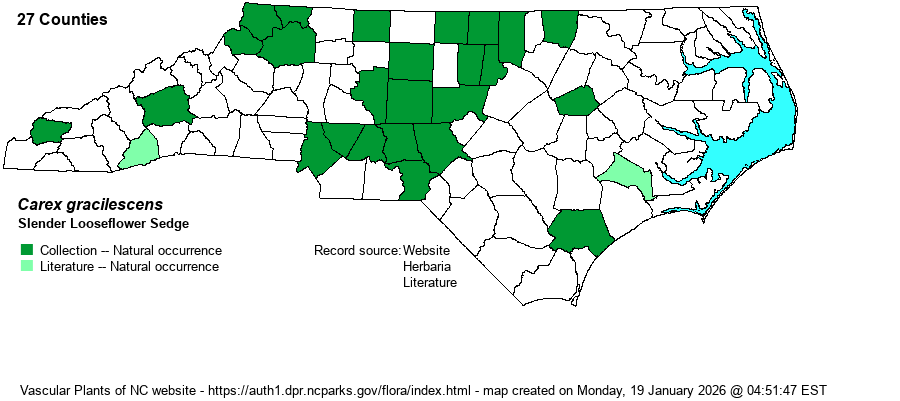| Author | Steudel | |
| Distribution | Piedmont and lower elevations of the Mountains; disjunct to Pender and Jones Counties. The large gap in the Mountains is puzzling. Montane specimens without images at UNCA and WCUH need to be vetted.
Southern Que. to WI, south to SC and eastern TX. | |
| Abundance | Uncommon in the eastern Piedmont, rare in the western Piedmont and Mountains, and very rare near the coast. It is certainly not S2 as the NCNHP suggests; the website editors suggest S3. | |
| Habitat | Mesic to moist hardwood forests, usually on slopes and usually in circumneutral soils (over slate, gabbro, and other mafic rocks); also flat marl forest (Pender County). | |
| Phenology | Flowering and fruiting April - early June. | |
| Identification | A member of the section Laxiflorae, thus needs careful identification. Unlike C. laxiflora, blanda, styloflexa, and chapmanii, the basal sheaths of C. gracilescens are red-purple, not brownish or tan or green. Other relatives in NC with red-purple sheaths are C. manhartii and C. purpurifera, both restricted to the Mountains. From both, C. gracilescens differs it its smaller perigynia (2.4-3.3 mm vs. 3.4-4.5 mm). | |
| Taxonomic Comments | None
The genus Carex is the largest in North America, and among the largest in the world. In temperate and boreal regions, Carex is often the dominant or co-dominant ground layer in many habitats. Seeds (achenes) are valuable food for birds and small mammals, while foliage is used by birds and mammals to make nests and as food by mammals. Species of Carex often look vastly different from one another -- spikes erect vs. drooping, tiny inflorescence vs. whopping, culms leafy vs. naked, perigynia beaked vs. beakless, stems densely bunched vs. single, etc. The genus has been divided into many sections (or groups), based on shared characters; some taxonomists have suggested that these be different genera, but that proves unworkable (so far). All Carex share the feature of a perigynium (an outer covering) which completely surrounds the achene (seed). This covering may fit tightly or loosely (like a small bladder), depending on which group or species. Details of perigynia shape, ornamentation, presence and size of beak, number of striations (or veins) are all important ID features. In recent years Rob Naczi and colleagues have stressed the importance of arrangement of perigynia -- whether spiral (3+ ranks) or distichous (2-ranked) -- and have named a number of new species as well as split off some older synonyms. Therefore, RAB's (1968) key, excellent for its time, can only be used in a general way today. Members of some sections of Carex are difficult to key out (notably Ovales, Laxiflorae, Griseae); this is in part due to variation among individuals of a species, or failings of the key. FNA has drawings of most species and some species may be found in two or more places within a key, to acount for variability. New species to NC, and new to science(!), continue to be found in NC. | |
| Other Common Name(s) | Slender Wood Sedge (the most prevalent common name for C. digitalis). | |
| State Rank | S2? [S3] | |
| Global Rank | G5? | |
| State Status | | |
| US Status | | |
| USACE-agcp | | |
| USACE-emp | | |

